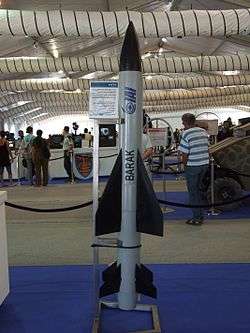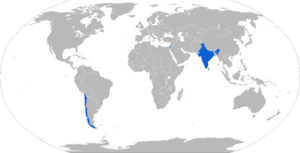Barak 1
Barak (Hebrew: ברק, lightning) is an Israeli surface-to-air missile (SAM) designed to be used as a ship-borne point-defense missile system against aircraft, anti-ship missiles, and UAVs.
| Barak I | |
|---|---|
 Barak 1 | |
| Type | Short range surface-to-air missile |
| Place of origin | Israel |
| Production history | |
| Manufacturer | Israel Aerospace Industries & Rafael Advanced Defense Systems |
| Specifications | |
| Mass | 98 kg (216 lb)[1] |
| Length | 2.1 m (6.9 ft)[1] |
| Diameter | 170 mm (6.7 in)[1] |
| Warhead | 22 kg (49 lb)[1] blast fragmentation warhead |
Detonation mechanism | Proximity fuze[1] |
| Wingspan | 685 mm (27.0 in)[1] |
Operational range | 0.5–12 km (0.3–7.5 mi)[1] |
| Flight altitude | 5.5 km (18,000 ft)[1] |
| Maximum speed | Mach 2.1 (720 m/s (1,600 mph))[1] |
Guidance system | Radar CLOS guidance |
Launch platform | Surface Ship |
Overview
The Barak SAM system is designed to replace or complement gun-based CIWS platforms, such as the Phalanx CIWS, with a more flexible and longer-range SAM. The missiles are mounted in an eight cell container (which requires little maintenance) and are launched straight up. The Barak SAM system's launcher uses a compact vertical launching system, with an 8-cell module weighing 1,700 kg (3,700 lb). Fire control is provided by an equally compact C3I system that weighs 1,300 kg (2,900 lb), which can either operate independently or in conjunction with other on-board sensors. Its C3I radar system provides 360-degree coverage and the missiles can take down an incoming missile as close as 500 metres (1,600 ft) away from the ship. Each Barak system (missile container, radar, computers and installation) costs about $24 million. The system is designed to defend against aircraft and anti-ship missiles, including sea-skimming missiles.[2]
Flight tests
The missile was tested on 24 March 2017 by the Indian Navy from INS Vikramaditya during Operation Readiness Inspection in the Arabian Sea.[3][4][5][6]
Operators

Allegations
The alleged Indian Barak missile purchase controversy was mainly due to allegations of defense industry corruption, and also due to allegations that the deal was over-priced and processed on a single-tender basis.
By 2013, the allegations were unproven and the investigations were inconclusive due to lack of evidence, and the case is likely to be closed.[2][9]
The investigation of the allegations began in 2006, and were done by the Central Bureau of Investigation, which arrested several people including the former Samata Party treasurer R.K. Jain.
On 23 December 2013, India's Defense Acquisition Council (DAC) headed by Defense Minister AK Antony cleared a second order of 262 Barak-I missiles for ₹880 crore (US$123 million).[7]
See also
References
- "Barak missile" (PDF). Rafael.co.il. Archived from the original (PDF) on 29 February 2012. Retrieved 18 November 2012.
- "Dubious deal". The Hindu. Retrieved 22 December 2013.
- "SpokespersonNavy on Twitter". Twitter. Retrieved 26 March 2017.
- "Indian navy successfully test fires surface-to-air missile from aircraft carrier". UPI. Retrieved 26 March 2017.
- "Indian Navy fires SAM Missile system from aircraft carrier INS Vikramaditya". Daily News & Analysis. 24 March 2017. Retrieved 26 March 2017.
- "Indian Navy launches Barak-1 from carrier". www.janes.com. Archived from the original on 2 June 2017. Retrieved 31 March 2017.
- "Defence ministry finally clears Barak missile deal with Israel". The Times of India. 23 December 2013. Retrieved 23 December 2013.
- "Four major acquisitions for the Navy and the Army approved". The Hindu. 24 December 2013. Retrieved 24 December 2013.
- "Israel rejects bribery charge, Barak missile probe may end". Hindustan Times. 21 December 2013. Retrieved 22 December 2013.
External links

| Wikimedia Commons has media related to Barak 1 missiles. |